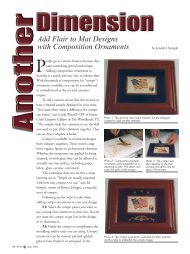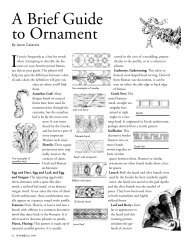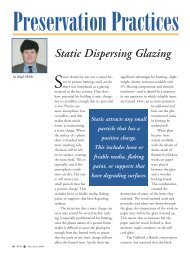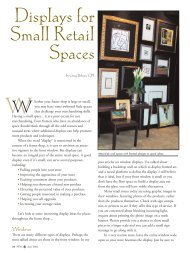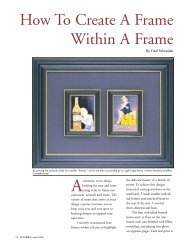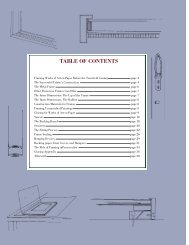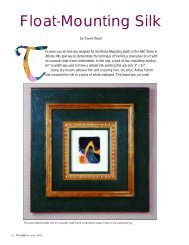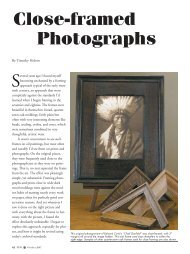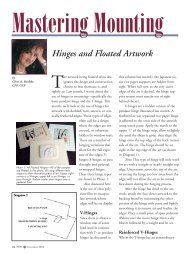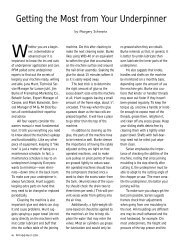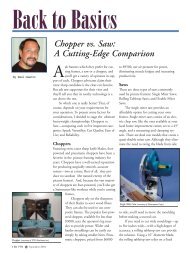To Needleart and Beyond - Picture Framing Magazine
To Needleart and Beyond - Picture Framing Magazine
To Needleart and Beyond - Picture Framing Magazine
You also want an ePaper? Increase the reach of your titles
YUMPU automatically turns print PDFs into web optimized ePapers that Google loves.
sional framer out there is actually<br />
sticking stuff down, right?<br />
Methods of Textile <strong>Framing</strong><br />
It is essential to establish specific<br />
<strong>and</strong> detailed techniques for framing<br />
works of art consisting of<br />
fibers.<br />
Lacing Technique: This method<br />
is used when, in order for the finished<br />
design to be aesthetically<br />
pleasing, the textile<br />
edges must be covered or<br />
rolled to the reverse side.<br />
An example of this is a<br />
piece of counted crossstitch,<br />
a type of needleart<br />
that falls under the larger<br />
umbrella of textile framing.<br />
In a counted cross-stitch,<br />
colorful cotton <strong>and</strong>/or<br />
metallic threads are stitched<br />
into a evenweave fiber by<br />
threading small x’s in <strong>and</strong><br />
out of the intersections of<br />
the fabric until the threads<br />
are united <strong>and</strong> the small x’s<br />
have created a finely<br />
detailed picture.<br />
<strong>To</strong> the eye of the<br />
beholder cross-stitch is as<br />
valuable as any original<br />
work of art <strong>and</strong> the professional<br />
framer should accept<br />
this <strong>and</strong> reject the “just stick it<br />
down” techniques. More modern<br />
day textiles include batik, a fiber<br />
design created using a wax resist<br />
<strong>and</strong> dyes to create a global textile<br />
that traditionally comes from exotic<br />
places like Africa.<br />
Typically the edges of these<br />
types of textile are not attractive<br />
<strong>and</strong> most people prefer that the<br />
edges be hidden. So, we lace them.<br />
The technique of lacing has been<br />
used for centuries to safely attach a<br />
fibered work of art to a mount<br />
36 PFM i December 2000<br />
board. It is accomplished by pulling<br />
the excess fabric to the reverse side,<br />
tying off the corners, <strong>and</strong> then the<br />
sides using lacing technique.<br />
(Details on this technique can be<br />
found in “Lacing <strong>Needleart</strong>,” PFM,<br />
December 1999.)<br />
Couching Technique: This technique<br />
is used when the art would<br />
be best served with the edges show-<br />
The rich fabric used in this shadowbox highlights the detail of the<br />
couched gloves <strong>and</strong> beaded bag. The gold fillet adds richness to the<br />
final creation.<br />
ing. This technique is more commonly<br />
used in mounting most<br />
types of textile art other than<br />
needleart. Examples are a crocheted<br />
doily, an alligator skin, a Navajo<br />
rug, or a zebra skin. Typically the<br />
edges of these types of art are interesting<br />
<strong>and</strong> hiding them would take<br />
away from the beauty of the piece.<br />
The art must be first carefully<br />
pinned to a substrate (consisting of<br />
a finished fiber) or board that will<br />
lend support as well as be an<br />
attractive background for the tex-<br />
tile. One by one, the pins are<br />
replaced by small stitches of thread<br />
that is as close to the fiber of the<br />
art as possible.<br />
The majority of the thread travels<br />
underneath the substrate with<br />
only a small stitch coming to the<br />
surface to capture the textile <strong>and</strong><br />
safely hold it onto the substrate or<br />
mounting board. The distance<br />
between these tiny stitches will<br />
be determined by the weight of<br />
the textile being held. Close the<br />
distance with heavier textiles<br />
<strong>and</strong> widen the distance with<br />
light, delicate textiles. (Details<br />
on this technique can be found<br />
in “The Couching Technique<br />
for <strong>Needleart</strong> <strong>Framing</strong>,” PFM,<br />
December 1995.)<br />
Choosing the Correct <strong>To</strong>ols<br />
Threads: The threads used for<br />
textile framing are as important<br />
as the stitching itself. Try<br />
to use a thread as close to the<br />
fiber of the textile as possible.<br />
Take the example of a football<br />
jersey, typically made of polyester.<br />
The longevity of the<br />
preservation mounting will be<br />
maximized if polyester thread<br />
is used to secure the artwork to<br />
the mounting board.<br />
Remember the invisible thread<br />
used to sew cotton clothing? Then<br />
you also remember that the seams<br />
began to come loose over time.<br />
The thread was actually stronger<br />
than the fiber itself <strong>and</strong> therefore<br />
wore out the fiber. Remember the<br />
simple statement, “Like threads to<br />
like fibers.”<br />
A delicate christening gown<br />
should be mounted using the delicate<br />
French h<strong>and</strong> sewing thread,<br />
the heavy Navajo rug would need<br />
the support of a heavy cotton cov



